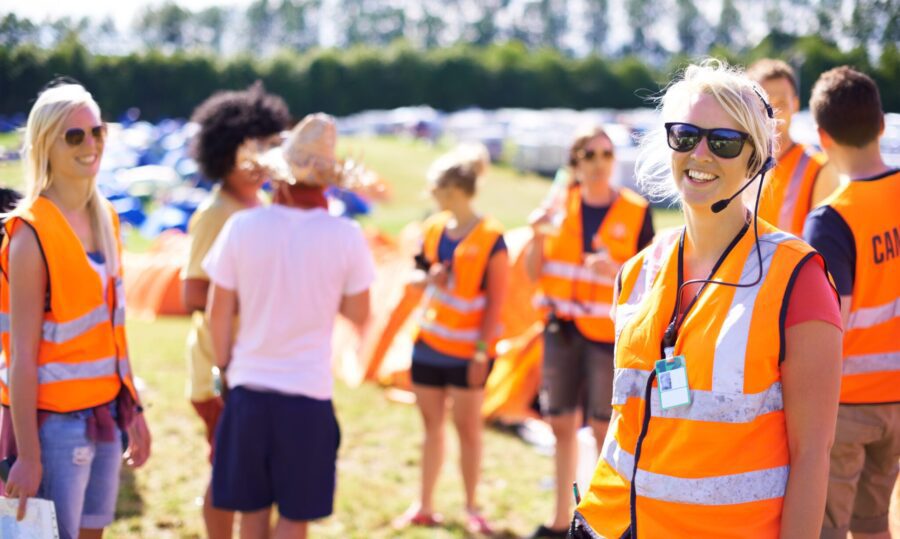When you host a concert, festival, or other event, you need to prioritize event risk management. If you’re not prepared, a situation can get out of control fast – and you could be held liable for any property damage and injuries that result. Conduct a thorough event risk assessment and take steps to minimize the threats.
Many Things Can Go Wrong During an Event
Anyone involved in event planning understands that a lot of work goes into creating a successful event. If anything goes wrong, the situation can fall apart fast.
Some potential risks event professionals need to consider include:
- No-Shows: Your event may hinge on key people, such as performers at a concert. If they’re late or don’t show up at all, you could face a disappointed – and possibly even angry – crowd.
- Technical Issues: If your sound system or other equipment malfunctions, the event may be unable to proceed. Consider the practicality of backup power sources to address potential power outages.
- Life Safety: If an emergency arises, it’s important to have a plan in place to inform attendees of the need to evacuate or shelter in place. Egress routes and exit doors should be maintained free of obstruction and clearly identified.
- Special Effects and Pyrotechnics: Special effects make events more special, but also create additional risk. The event planner, venue and local authorities should review and collaborate to ensure proper safeguards are in place.
- Stage and Lighting: Sound and lighting are necessary for most events. Precautions should be taken to ensure they are adequately installed and secured. This is especially important for outdoor events that may be subject to high wind speeds.
- Weather: If you’re holding an outdoor event, weather is a major factor. Rain, hail and lightning can ruin the day. Extreme temperatures are another threat. For instance, heat stroke can be a major risk for events taking place on hot summer days. In fact, even indoor events may be impacted by severe storms that cause flooding, strong winds and power outages.
- Crowd Management: Crowds can become lethal if they’re not controlled. When people are packed into a space too densely, pressure from one direction can push people into each other with no room to move. This can cause the people who become trapped in the crowd to asphyxiate. According to Rolling Stone, 10 people died after a crowd surge at the 2021 Astroworld festival in Houston. Wired says more than 150 people died in a crowd crush while celebrating Halloween in Seoul in 2022.
- Violence: Most people attend special events to have fun, but violence is a risk. Individuals may become violent after drinking or a dispute may turn violent. Some people may even attend the event with violent intentions. In 2017, a man began shooting at a music festival from the window of his Las Vegas hotel room. According to Business Insider, 58 people were killed and more than 850 were injured.
- Child Safety: If your event welcomes minors, child safety is an important issue. Children could become separated from their guardians, ingest something harmful or hurt themselves. Kidnapping and other crimes that target children are also a risk.
- Food Poisoning: Events that include food are at risk for food poisoning. This risk is especially high if food is left out in hot weather for extended periods of time. The USDA warns that bacteria can double in as little as 20 minutes when left in the “Danger Zone” of temperatures: between 40 and 140 degrees Fahrenheit.
- Fire: If your event includes cooking tools, you may have elevated fire risks. Improperly disposed cigarettes and faulty wiring can also start a fire.
- Alcohol and Drugs: When events involve alcohol, alcohol risks are a concern. These include alcohol poisoning, drunk driving and rowdiness. Event participants may also try to sneak alcohol and drugs into events.
- Medical Emergencies: The larger the group, the higher the odds of a medical emergency. Medical situations could range from minor first aid incidents to serious medical conditions such as heart attacks. The emergency action plan should consider having the proper level of medical care onsite or on standby with the local jurisdiction.
Conducting an Event Risk Assessment
Before you host an event, you need to conduct an event risk assessment. This should be a thorough process in which you consider all of the possible risks that could threaten your event.
- What risks exist? Identify hazards, both manmade and natural.
- What could result from each hazard? Consider the possibility of property damage and injury.
- How likely is each risk? Although you don’t want to neglect anything, some risks are much more likely and may need to be your priority.
Identifying Appropriate Risk Controls
Once you’ve identified the hazards that threaten your event, identify ways to eliminate or mitigate risks.
You’ll need risk controls to address the following:
- Crowd Control: Proper crowd control tactics can prevent crushes and chaos. Consider the capacity limits and administrative controls you’ll need to avoid overcrowding. You need to make sure you have enough exits and consider how the crowd will move when leaving to prevent bottlenecks.
- Security: Your security needs will depend on the nature and size of your event. You might need security personnel and metal detectors to check people as they enter the event to make sure they’re not carrying dangerous items. You may also need security workers to monitor the event as it progresses and to respond to any security issues, such as a fight that breaks out or a child who goes missing.
- Medical: You need to be ready in case someone experiences an injury or health problem. Have first aid supplies on hand and know how to obtain additional medical care if needed. Also consider whether you need medical staff on site. If your event is taking place outside in the heat, you may need cooling stations and water.
- Safety: Could the people at your event fall, be burned, be cut or drown? Consider any hazards that could result in injury and take steps to mitigate risks.
Implementing Your Event Risk Management Plan
To help ensure your event runs without a hitch, you need to iron out all the details of your risks management plan.
- Identify who is in charge of what. When something goes wrong, event organizers may play the blame game, pointing at others as the ones who dropped the ball. Don’t let critical risk control measures slip through the cracks – assign tasks to individuals and make sure everyone knows what they need to do.
- Create a timeline. Don’t be unprepared on the day of the event. Create a timeline of the tasks you need to carry out and the supplies you need to secure in the days and hours leading up to the event.
- Document your risk control measures. Documentation can help in two critical ways. Firstly, solid documentation can help you keep your risk management plan on track – you’ll be checking off risk control measures as you carry them out, meaning you’ll know exactly what has happened and what hasn’t. Secondly, if anything does go wrong, you’ll have evidence to show you took reasonable steps to prevent incidents.
Secure Event Insurance
Event risk management strategies can help your event go smoothly and reduce your liability. However, some incidents are outside your control. If something goes wrong, you won’t need to worry if you have robust insurance protection. Higginbotham offers insurance packages for concert promoters, concert venues, event planners, theatrical productions and others involved in entertainment and events. Learn more.






